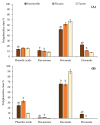Composition and Biological Properties of Blanched Skin and Blanch Water Belonging to Three Sicilian Almond Cultivars
- PMID: 36986275
- PMCID: PMC10058606
- DOI: 10.3390/nu15061545
Composition and Biological Properties of Blanched Skin and Blanch Water Belonging to Three Sicilian Almond Cultivars
Abstract
The almond industry produces, by bleaching and stripping, two by-products: blanched skin (BS) and blanch water (BW). The aim of this study was to investigate the nutritional and polyphenolic profile, as well as the antioxidant, antimicrobial, antiviral, and potential prebiotic effects of BS and BW from three different Sicilian cultivars. The total phenols and flavonoids contents were ≥1.72 and ≥0.56 g gallic acid equivalents and ≥0.52 and ≥0.18 g rutin equivalents/100 g dry extract (DE) in BS and BW, respectively. The antioxidant activity, evaluated by 2,2-diphenyl-1-picrylhydrazyl scavenging ability, trolox equivalent antioxidant capacity, ferric-reducing antioxidant power, and oxygen radical absorbance capacity, was ≥3.07 and ≥0.83 g trolox equivalent/100 g DE in BS and BW, respectively. Isorhamnetin-3-O-glucoside was the most abundant flavonoid detected in both by-products. No antimicrobial effect was recorded, whereas BS samples exerted antiviral activity against herpes simplex virus 1 (EC50 160.96 μg/mL). BS also showed high fibre (≥52.67%) and protein (≥10.99) contents and low fat (≤15.35%) and sugars (≤5.55%), making it nutritionally interesting. The present study proved that the cultivar is not a discriminating factor in determining the chemical and biological properties of BS and BW.
Keywords: almond by-products; antimicrobial activity; antioxidant properties; antiviral activity; cultivar; nutritional profile; polyphenols; prebiotic effect.
Conflict of interest statement
The authors declare no conflict of interest.
Figures







Similar articles
-
Antioxidant activity and total phenolic and flavonoids content variations of leaves extracts of white Horehound (Marrubium vulgare Linné) from three geographical origins.Ann Pharm Fr. 2016 Nov;74(6):453-462. doi: 10.1016/j.pharma.2016.07.002. Epub 2016 Aug 21. Ann Pharm Fr. 2016. PMID: 27553439
-
Total phenolic, total flavonoid content, and antioxidant capacity of the leaves of Meyna spinosa Roxb., an Indian medicinal plant.Chin J Nat Med. 2013 Mar;11(2):149-57. doi: 10.1016/S1875-5364(13)60042-4. Chin J Nat Med. 2013. PMID: 23787182
-
Phenolic compounds and antioxidant capacities of 10 common edible flowers from China.J Food Sci. 2014 Apr;79(4):C517-25. doi: 10.1111/1750-3841.12404. Epub 2014 Mar 12. J Food Sci. 2014. PMID: 24621197
-
HR-LC-ESI-Orbitrap-MS based metabolite profiling of Prunus dulcis Mill. (Italian cultivars Toritto and Avola) husks and evaluation of antioxidant activity.Phytochem Anal. 2019 Jul;30(4):415-423. doi: 10.1002/pca.2824. Epub 2019 Feb 14. Phytochem Anal. 2019. PMID: 30762260
-
Valorization Challenges to Almond Residues: Phytochemical Composition and Functional Application.Molecules. 2017 Oct 20;22(10):1774. doi: 10.3390/molecules22101774. Molecules. 2017. PMID: 29053616 Free PMC article. Review.
Cited by
-
Almond By-Products: A Comprehensive Review of Composition, Bioactivities, and Influencing Factors.Foods. 2025 Mar 19;14(6):1042. doi: 10.3390/foods14061042. Foods. 2025. PMID: 40232093 Free PMC article. Review.
-
The Influence of Pedo-Climatic Conditions on the Micromorphological, Phytochemical Features, and Biological Properties of Leaves of Saponaria sicula Raf.Int J Mol Sci. 2023 Jul 20;24(14):11693. doi: 10.3390/ijms241411693. Int J Mol Sci. 2023. PMID: 37511452 Free PMC article.
-
Citrus Pomace as a Source of Plant Complexes to Be Used in the Nutraceutical Field of Intestinal Inflammation.Antioxidants (Basel). 2024 Jul 19;13(7):869. doi: 10.3390/antiox13070869. Antioxidants (Basel). 2024. PMID: 39061937 Free PMC article.
-
Beyond the Scent: New Evidence about Micromorphological, Phytochemical and Biological Features of Plumeria rubra 'Tonda Palermitana' (Apocynaceae).Plants (Basel). 2024 Sep 4;13(17):2479. doi: 10.3390/plants13172479. Plants (Basel). 2024. PMID: 39273963 Free PMC article.
-
Effects of the Agrobacterium rhizogenes rolC Gene Insertion on Secondary Metabolites Profile and In Vitro Biological Activity of Acmella oleracea (L.) R.K. Jansen.Plants (Basel). 2025 May 1;14(9):1373. doi: 10.3390/plants14091373. Plants (Basel). 2025. PMID: 40364402 Free PMC article.
References
-
- Garcia-Perez P., Xiao J., Munekata P.E.S., Lorenzo J.M., Barba F.J., Rajoka M.S.R., Barros L., Mascoloti Sprea R., Amaral J.S., Prieto M.A., et al. Revalorization of Almond By-Products for the Design of Novel Functional Foods: An Updated Review. Foods. 2021;10:1823. doi: 10.3390/foods10081823. - DOI - PMC - PubMed
-
- Smeriglio A., Mandalari G., Bisignano C., Filocamo A., Barreca D., Bellocco E., Trombetta D. Polyphenolic content and biological properties of Avola almond (Prunus dulcis Mill. D.A. Webb) skin and its industrial byproducts. Ind. Crops Prod. 2016;83:283–293. doi: 10.1016/j.indcrop.2015.11.089. - DOI
MeSH terms
Substances
Grants and funding
LinkOut - more resources
Full Text Sources
Medical
Molecular Biology Databases

